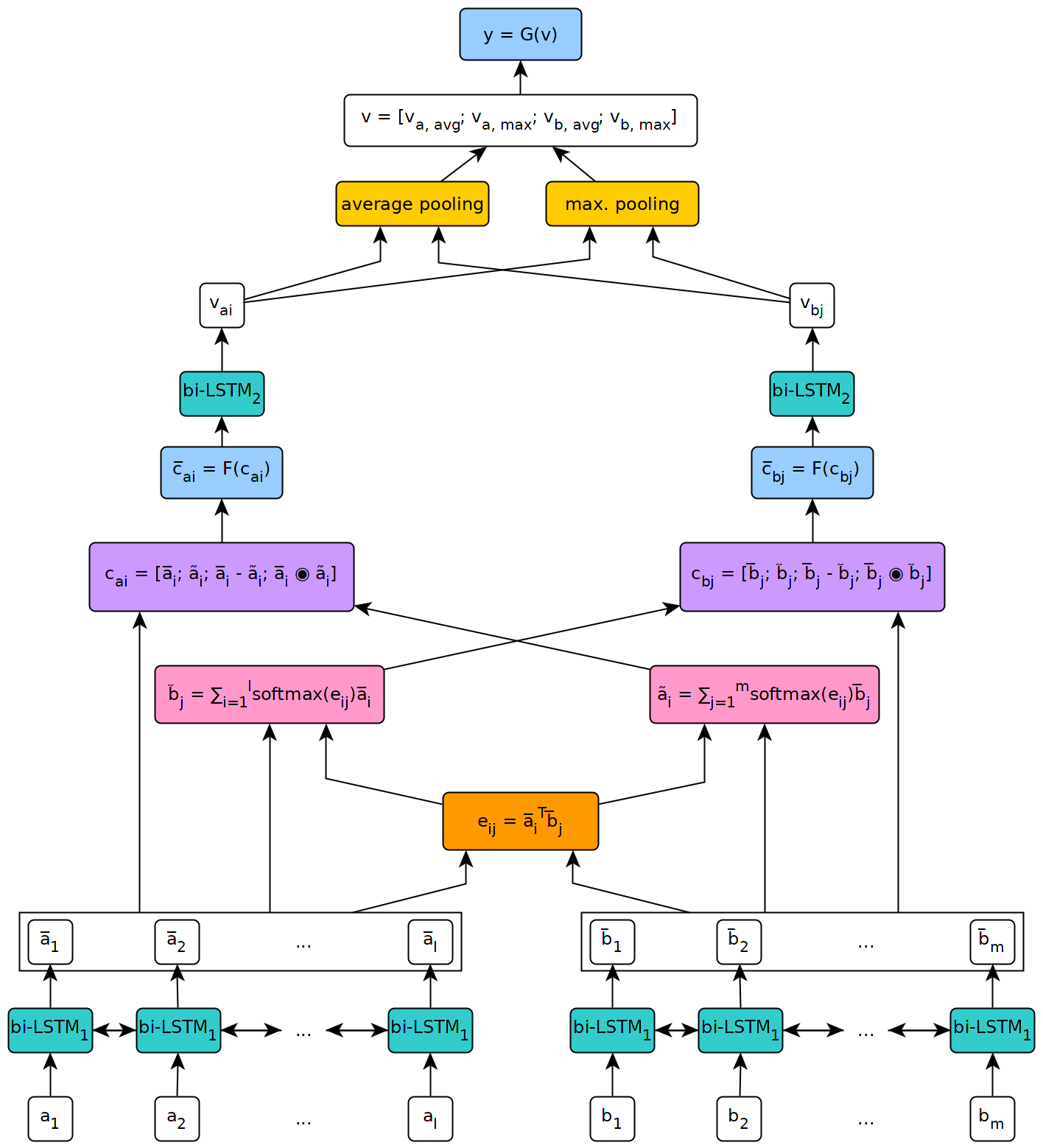Implementation of the ESIM model for natural language inference with PyTorch
This repository contains an implementation with PyTorch of the sequential model presented in the paper "Enhanced LSTM for Natural Language Inference" by Chen et al. in 2016.
The figure below illustrates a high-level view of the model's architecture.
To use the model defined in this repository, you will first need to install PyTorch on your machine by following the steps
described on the package's official page (this step is only necessary if you use
Windows).
Then, to install the dependencies necessary to run the model, simply execute the command pip install --upgrade . from within
the cloned repository (at the root, and preferably inside of a virtual environment).
The fetch_data.py script located in the scripts/ folder of this repository can be used to download some NLI dataset and pretrained word embeddings. By default, the script fetches the SNLI corpus and the GloVe 840B 300d embeddings. Other datasets can be downloaded by simply passing their URL as argument to the script (for example, the MultNLI dataset).
The script's usage is the following:
fetch_data.py [-h] [--dataset_url DATASET_URL]
[--embeddings_url EMBEDDINGS_URL]
[--target_dir TARGET_DIR]
where target_dir is the path to a directory where the downloaded data must be saved (defaults to ../data/).
For MultiNLI, the matched and mismatched test sets need to be manually downloaded from Kaggle and the corresponding .txt files copied in the multinli_1.0 dataset folder.
Before the downloaded corpus and embeddings can be used in the ESIM model, they need to be preprocessed. This can be done with the preprocess_*.py scripts in the scripts/preprocessing folder of this repository. The preprocess_snli.py script can be used to preprocess SNLI, preprocess_mnli.py to preprocess MultiNLI, and preprocess_bnli.py to preprocess the Breaking NLI (BNLI) dataset. Note that when calling the script fot BNLI, the SNLI data should have been preprocessed first, so that the worddict produced for it can be used on BNLI.
The scripts' usage is the following (replace the * with snli, mnli or bnli):
preprocess_*.py [-h] [--config CONFIG]
where config is the path to a configuration file defining the parameters to be used for preprocessing. Default
configuration files can be found in the config/preprocessing folder of this repository.
The train_*.py scripts in the scripts/training folder can be used to train the ESIM model on some training data and validate it on some validation data.
The script's usage is the following (replace the * with snli or mnli):
train_*.py [-h] [--config CONFIG] [--checkpoint CHECKPOINT]
where config is a configuration file (default ones are located in the config/training folder), and checkpoint is an
optional checkpoint from which training can be resumed. Checkpoints are created by the script after each training epoch, with
the name esim_*.pth.tar, where '*' indicates the epoch's number.
The test_*.py scripts in the scripts/testing folder can be used to test a pretrained ESIM model on some test data.
To test on SNLI, use the test_snli.py script as follows:
test_snli.py [-h] test_data checkpoint
where test_data is the path to some preprocessed test set, and checkpoint is the path to a checkpoint produced by the
train_snli.py script (either one of the checkpoints created after the training epochs, or the best model seen during
training, which is saved in data/checkpoints/SNLI/best.pth.tar - the difference between the esim_*.pth.tar files and
best.pth.tar is that the latter cannot be used to resume training, as it doesn't contain the optimizer's state).
The test_snli.py script can also be used on the Breaking NLI dataset with a model pretrained on SNLI.
To test on MultiNLI, use the test_mnli.py script as follows:
test_mnli.py [-h] [--config CONFIG] checkpoint
where config is a configuration file (a default one is available in config/testing) and checkpoint is a checkpoint
produced by the train_mnli.py script.
The test_mnli.py script makes predictions on MultiNLI's matched and mismatched test sets and saves them in .csv files. To get the classification accuracy associated to the model's predictions, the .csv files it produces need to be submitted to the Kaggle competitions for MultiNLI.
A model pre-trained on SNLI is made available in the data/checkpoints/SNLI folder of this repository. The model was trained
with the parameters defined in the default configuration files provided in config/.
To test it, simply execute python test_snli.py ../../preprocessed/SNLI/test_data.pkl ../../data/checkpoints/best.pth.tar
from within the scripts/testing folder.
The pretrained model achieves the following performance on the SNLI dataset:
| Split | Accuracy (%) |
|---|---|
| Train | 93.2 |
| Dev | 88.4 |
| Test | 88.0 |
The results are in line with those presented in the paper by Chen et al.
On the Breaking NLI dataset, published by Glockner et al. in 2018, the model reaches 65.5% accuracy, as reported in the paper.
On MultiNLI, the model reaches the following accuracy:
| Split | Matched | Mismatched |
|---|---|---|
| Dev | 77.0 % | 76.8 % |
| Test | 76.6 % | 75.8 % |
These results are slightly above what was reported by Williams et al. in their MultiNLI paper.
